Wildfire Impacts on Groundwater Aquifers: A Case Study of the 1996 Honey Boy Fire in Beaver County, Utah, USA
Abstract
:1. Introduction
2. Methods
3. Results
PostGIS
4. Discussion
5. Conclusions
Author Contributions
Funding
Acknowledgments
Conflicts of Interest
Appendix A
References
- Ebel, B.A.; Moody, J.A. Rethinking infiltration in wildfire-affected soils. Hydrol. Process. 2013, 27, 1510–1514. [Google Scholar] [CrossRef]
- Gray, M.E.; Zachmann, L.J.; Dickson, B.G. A weekly, continually updated dataset of the probability of large wildfires across western US forests and woodlands. Earth Syst. Sci. Data 2018, 10, 1715–1727. [Google Scholar] [CrossRef] [Green Version]
- Riedel, T.; Weber, T.K.D. Review: The influence of global change on Europe’s water cycle and groundwater recharge. Hydrogeol. J. 2020, 28, 1939–1959. [Google Scholar] [CrossRef]
- Girona-Garcia, A.; Vieira, D.C.S.; Silva, J.; Fernandez, C.; Robichaud, P.R.; Keizer, J.J. Effectiveness of post-fire soil erosion mitigation treatments: A systematic review and meta-analysis. Earth Sci. Rev. 2021, 217, 103611. [Google Scholar] [CrossRef]
- Lopes, A.R.; Girona-Garcia, A.; Corticeiro, S.; Martins, R.; Keizer, J.J.; Vieira, D.C.S. What is wrong with post-fire soil erosion modelling? A meta-analysis on current approaches, research gaps, and future directions. Earth Surf. Process. Landf. 2021, 46, 205–219. [Google Scholar] [CrossRef]
- Tsinnajinnie, L.M.; Frisbee, M.D.; Wilson, J.L. Groundwater from perennial springs provide refuge from wildfire impacts in mountainous semiarid watershed. J. Hydrol. 2021, 596, 125701. [Google Scholar] [CrossRef]
- Lohse, K.; Berhe, A. Soil Signals Tell of Landscape Disturbances. Eos, Transactions, American Geophysical Union. 2020. Available online: https://eos.org/science-updates/soil-signals-tell-of-landscape-disturbances (accessed on 28 October 2020).
- Larson-Nash, S.S.; Robichaud, P.R.; Pierson, F.B.; Moffet, C.A.; Williams, C.J.; Spaeth, K.E.; Brown, R.E.; Lewis, S.A. Recovery of small-scale infiltration and erosion after wildfires. J. Hydrol. Hydromech. 2018, 66, 261–270. [Google Scholar] [CrossRef] [Green Version]
- Ebel, B.A. Temporal evolution of measured and simulated infiltration following wildfire in the Colorado Front Range, USA: Shifting thresholds of runoff generation and hydrologic hazards. J. Hydrol. 2020, 585, 124765. [Google Scholar] [CrossRef]
- Shakesby, R.A.; Doerr, S.H. Wildfire as a hydrological and geomorphological agent. Earth Sci. Rev. 2006, 74, 269–307. [Google Scholar] [CrossRef]
- Cawson, J.G.; Sheridan, G.J.; Smith, H.G.; Lane, P.N.J. Surface runoff and erosion after prescribed burning and the effect of different fire regimes in forests and shrublands: A review. Int. J. Wildland Fire 2012, 21, 857–872. [Google Scholar] [CrossRef]
- Fernandez, C.; Fonturbel, T.; Vega, J.A. Wildfire burned soil organic horizon contribution to runoff and infiltration in a Pinus pinaster forest soil. J. For. Res. 2019, 24, 86–92. [Google Scholar] [CrossRef]
- Balfour, V.N.; Doerr, S.H.; Robichaud, P.R. The temporal evolution of wildfire ash and implications for post-fire infiltration. Int. J. Wildland Fire 2014, 23, 733–745. [Google Scholar] [CrossRef] [Green Version]
- Nyman, P.; Sheridan, G.J.; Smith, H.G.; Lane, P.N.J. Modeling the effects of surface storage, macropore flow and water repellency on infiltration after wildfire. J. Hydrol. 2014, 513, 301–313. [Google Scholar] [CrossRef]
- Ebel, B.A.; Moody, J.A. Synthesis of soil-hydraulic properties and infiltration timescales in wildfire-affected soils. Hydrol. Process. 2017, 31, 324–340. [Google Scholar] [CrossRef]
- Stavi, I. Wildfires in grasslands and shrublands: A review of impacts on vegetation, soil, hydrology, and geomorphology. Water 2019, 11, 1042. [Google Scholar] [CrossRef] [Green Version]
- Malkinson, D.; Wittenberg, L. Post fire induced soil water repellency-Modeling short and long-term processes. Geomorphology 2011, 125, 186–192. [Google Scholar] [CrossRef]
- Robichaud, P.R.; Wagenbrenner, J.W.; Pierson, F.B.; Spaeth, K.E.; Ashmun, L.E.; Moffet, C.A. Infiltration and interrill erosion rates after a wildfire in western Montana, USA. Catena 2016, 142, 77–88. [Google Scholar] [CrossRef] [Green Version]
- Dymov, A.A.; Abakumov, E.V.; Bezkorovaynaya, I.N.; Prokushkin, A.S.; Kuzyakov, Y.V.; Milanovsky, E.Y. Impact of forest fire on soil properties. Theor. Appl. Ecol. 2018, 4, 13–23. [Google Scholar] [CrossRef]
- Certini, G.; Moya, D.; Lucas-Borja, M.E.; Mastrolonardo, G. The impact of fire on soil-dwelling biota: A review. For. Ecol. Manag. 2021, 488, 118989. [Google Scholar] [CrossRef]
- Peterson, C.J. Review of termite forest ecology and opportunities to investigate the relationship of termites to fire. Sociobiology 2010, 56, 313–352. [Google Scholar]
- Mastrorillo, L.; Mazza, R.; Viaroli, S. Recharge process of a dune aquifer (Roman coast, Italy). Acque Sotter. Ital. J. Groundw. 2018, 7, 7–19. [Google Scholar] [CrossRef]
- Giambastiani, B.M.S.; Greggio, N.; Nobili, G.; Dinelli, E.; Antonellini, M. Forest fire effects on groundwater in a coastal aquifer (Ravenna, Italy). Hydrol. Process. 2018, 32, 2377–2389. [Google Scholar] [CrossRef]
- Moody, J.A.; Kinner, D.A.; Úbeda, X. Linking hydraulic properties of fire-affected soils to infiltration and water repellency. J. Hydrol. 2009, 379, 291–303. [Google Scholar] [CrossRef]
- Beatty, S.M.; Smith, J.E. Dynamic soil water repellency and infiltration in post-wildfire soils. Geoderma 2013, 192, 160–172. [Google Scholar] [CrossRef]
- Cawson, J.G.; Nyman, P.; Smith, H.G.; Lane, P.N.J.; Sheridan, G.J. How soil temperatures during prescribed burning affect soil water repellency, infiltration and erosion. Geoderma 2016, 278, 12–22. [Google Scholar] [CrossRef]
- Mansilha, C.; Melo, A.; Martins, Z.E.; Ferreira, I.M.P.L.V.O.; Pereira, A.M.; Marques, J.E. Wildfire effects on groundwater quality from springs connected to small public supply systems in a peri-urban forest area (Braga Region, NW Portugal). Water 2020, 12, 1146. [Google Scholar] [CrossRef] [Green Version]
- Dimitriadou, S.; Katsanou, K.; Charalabopoulos, S.; Lambrakis, N. Interpretation of the Factors Defining Groundwater Quality of the Site Subjected to the Wildfire of 2007 in Ilia Prefecture, South-Western Greece. Geosciences 2018, 8, 108. [Google Scholar] [CrossRef] [Green Version]
- Pham, H.V.; Le, P.; Berli, M. A data-driven approach to quantifying the correlation between groundwater and wildfire in the United States. In Proceedings of the American Geophysical Union Fall Meeting, Online, 1–17 December 2020; p. H087-0025. [Google Scholar]
- Schneider, K.E.; Rust, A.J.; Randall, J.; Hogue, T.S. Modelling post-fire hydrologic recovery in snow dominated catchments in Colorado’s San Juan Mountains. In Proceedings of the American Geophysical Union Fall Meeting, Online, 1–17 December 2020; p. H095-06. [Google Scholar]
- ArcGIS. US Wildfires 1980–2016. Available online: https://hub.arcgis.com/datasets/tga::us-wildfires-1980-2016 (accessed on 21 April 2021).
- U.S. Geological Survey. Active Groundwater Level Network. Available online: https://groundwaterwatch.usgs.gov/default.asp (accessed on 21 April 2021).
- National Wildfire Coordinating Group. Size Class of Fire. Available online: https://www.nwcg.gov/term/glossary/size-class-of-fire (accessed on 1 November 2020).
- Belsley, D.A.; Kuh, E.; Welsch, R.E. Regression Diagnostics; John Wiley and Sons, Inc.: Hoboken, NJ, USA, 1980. [Google Scholar]
- Lagarias, J.C.; Reeds, J.A.; Wright, M.H.; Wright, P.E. Convergence properties of the Nelder-Mead simplex method in low dimensions. SIAM J. Optim. 1998, 9, 112–147. [Google Scholar] [CrossRef] [Green Version]
- Swensen, J.; Romboy, D. Utah is Nation’s Hot Spot for Wildfires. Deseret News. 6 August 1996. Available online: https://www.deseret.com/1996/8/6/19258572/utah-is-nation-s-hot-spot-for-wildfires (accessed on 21 April 2021).
- Burden, C.B. Ground-Water Conditions in Utah; Report No. 42; Division of Water Resources, Utah Department of Natural Resources: Salt Lake City, UT, USA, 2001.
- Williams, C.J.; Pierson, F.B.; Al-Hamdan, O.Z.; Kormos, P.R.; Hardegree, S.P.; Clark, P.E. Can wildfire serve as an ecohydrologic threshold- reversal mechanism on juniper-encroached shrublands? Ecohydrology 2014, 7, 453–477. [Google Scholar] [CrossRef]
- Goldshleger, N.; Ben-Dor, E.; Lugassi, R.; Eshel, G. Soil degradation monitoring by remote sensing: Examples with three degradation processes. Soil Sci. Soc. Am. J. 2010, 74, 1433–1445. [Google Scholar] [CrossRef]
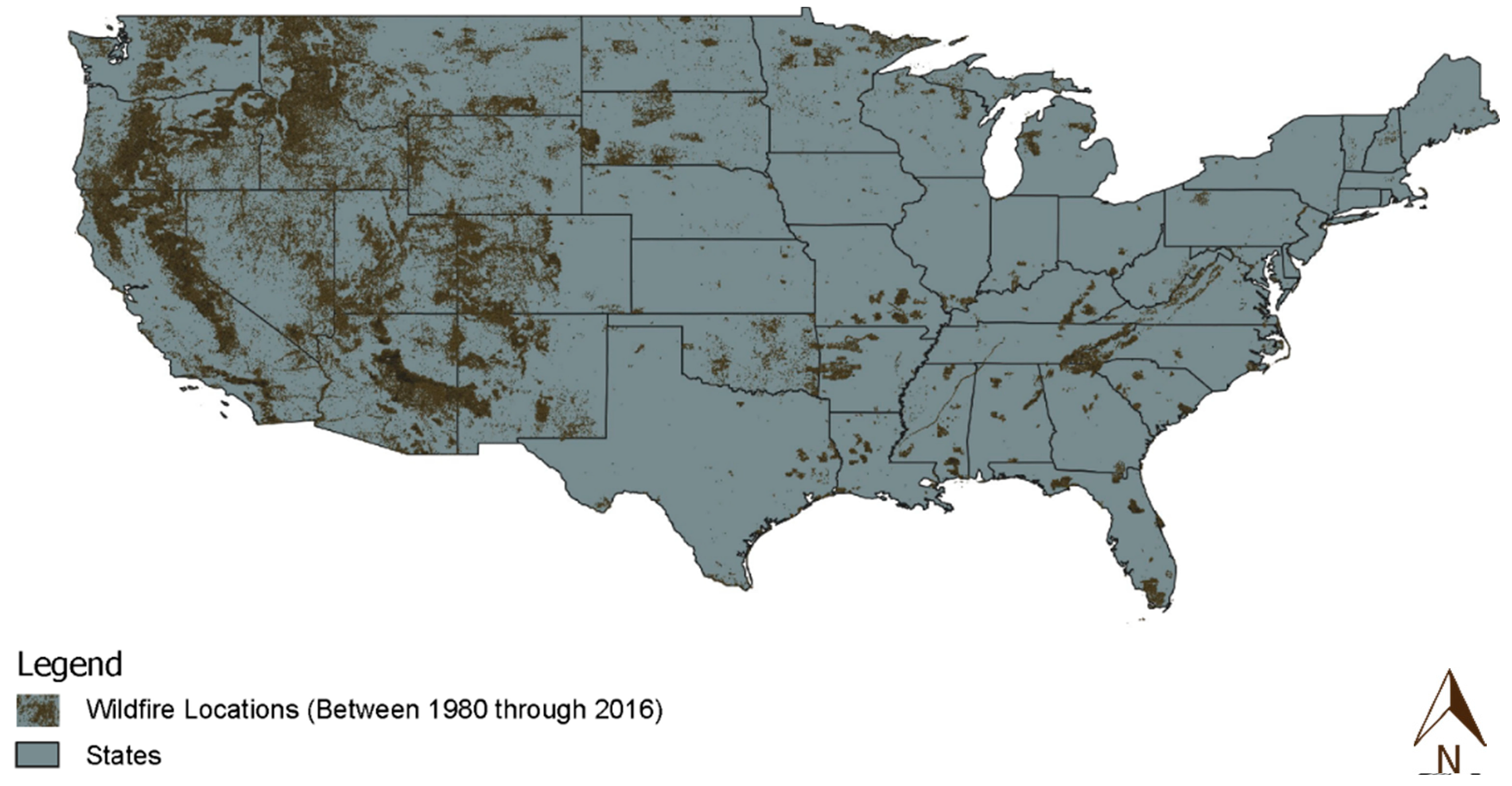
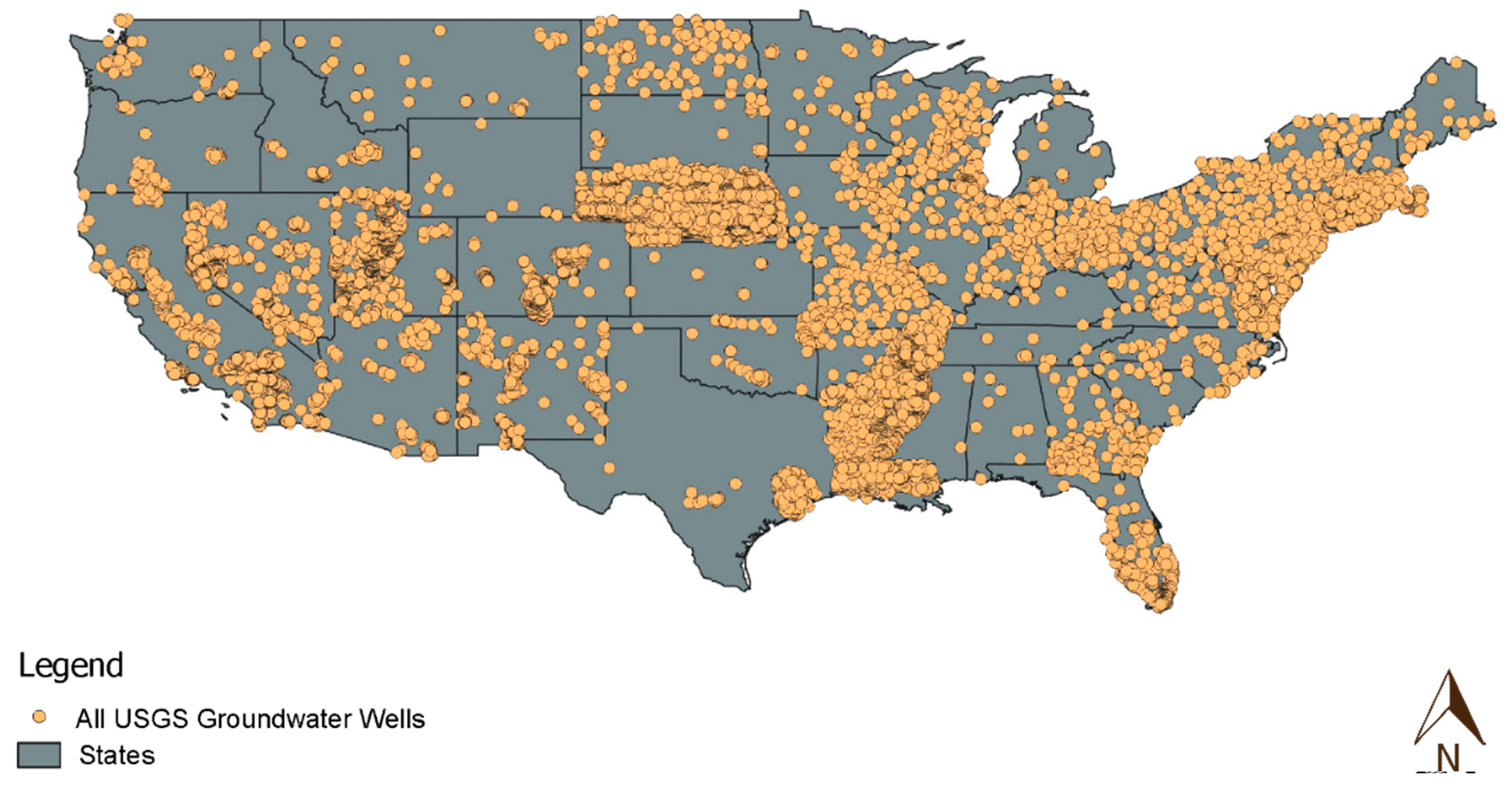
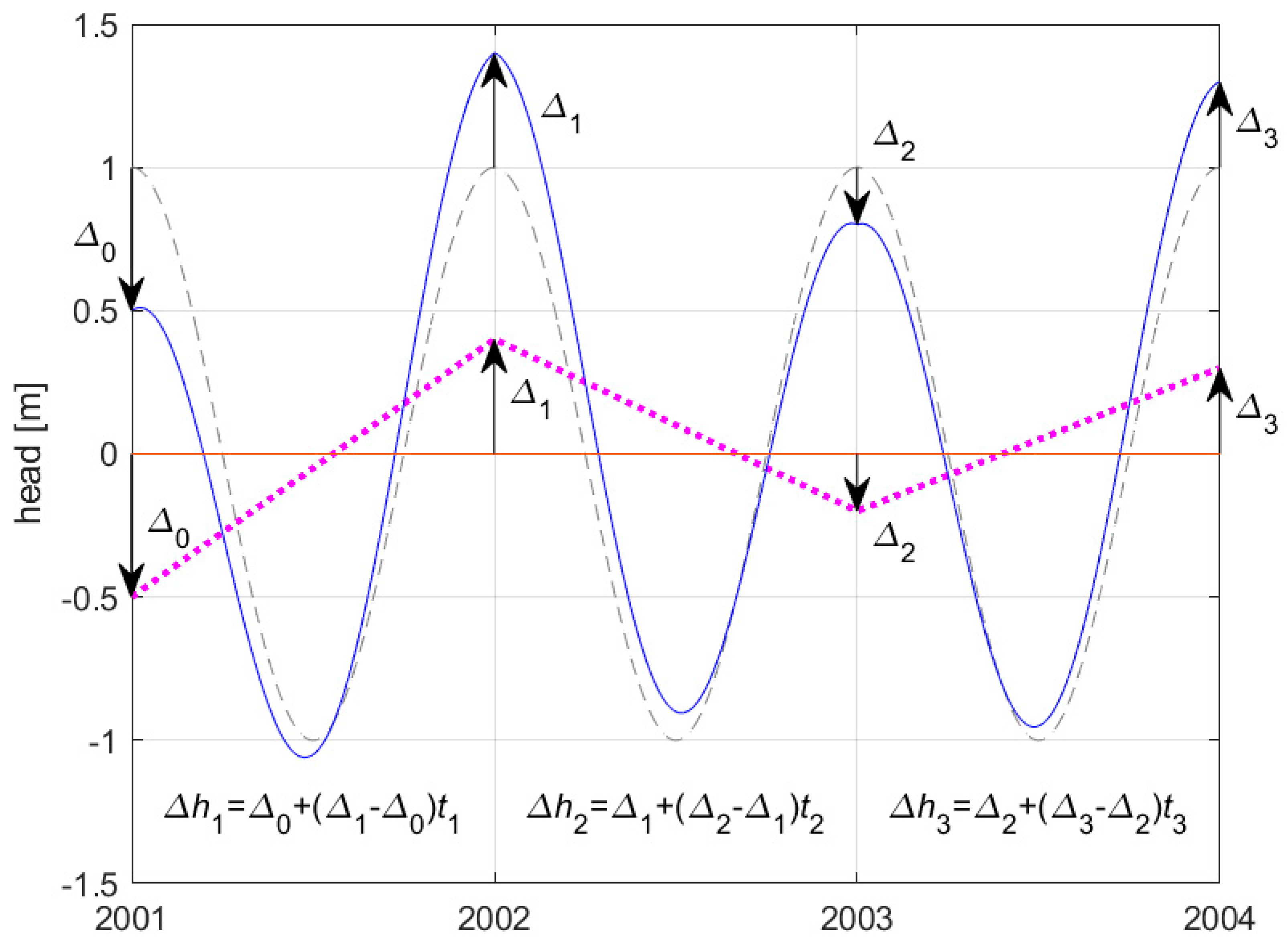

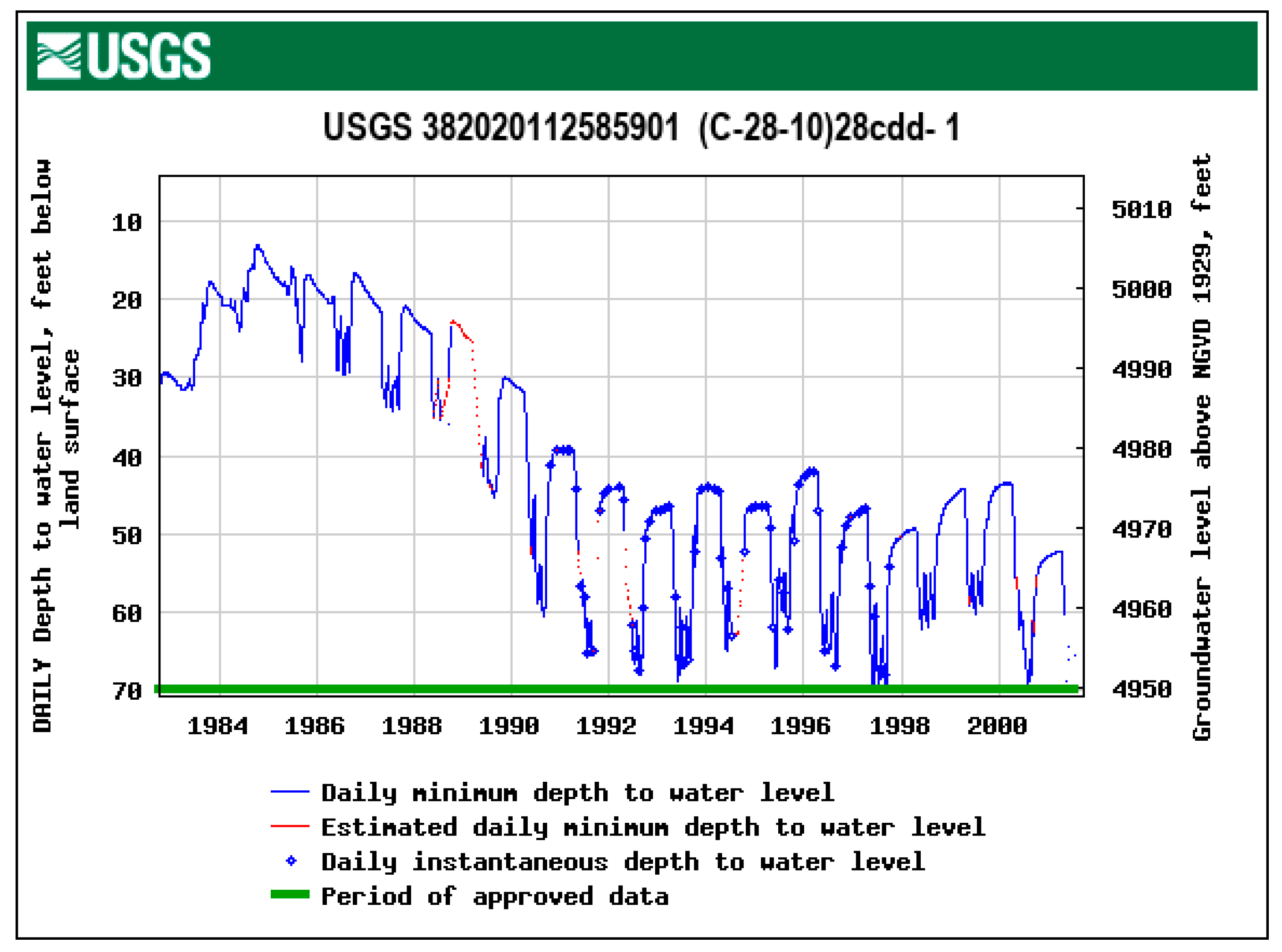
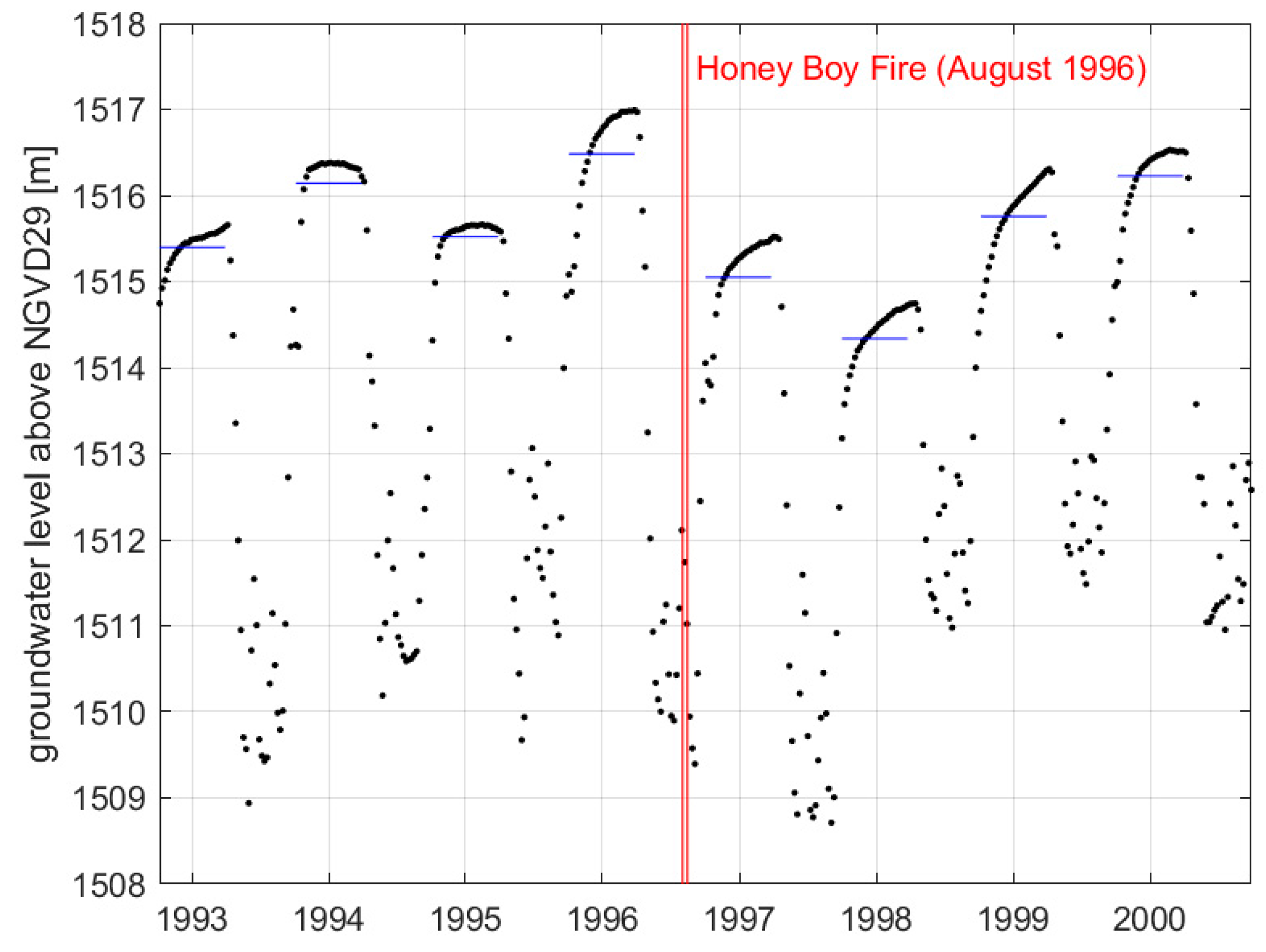


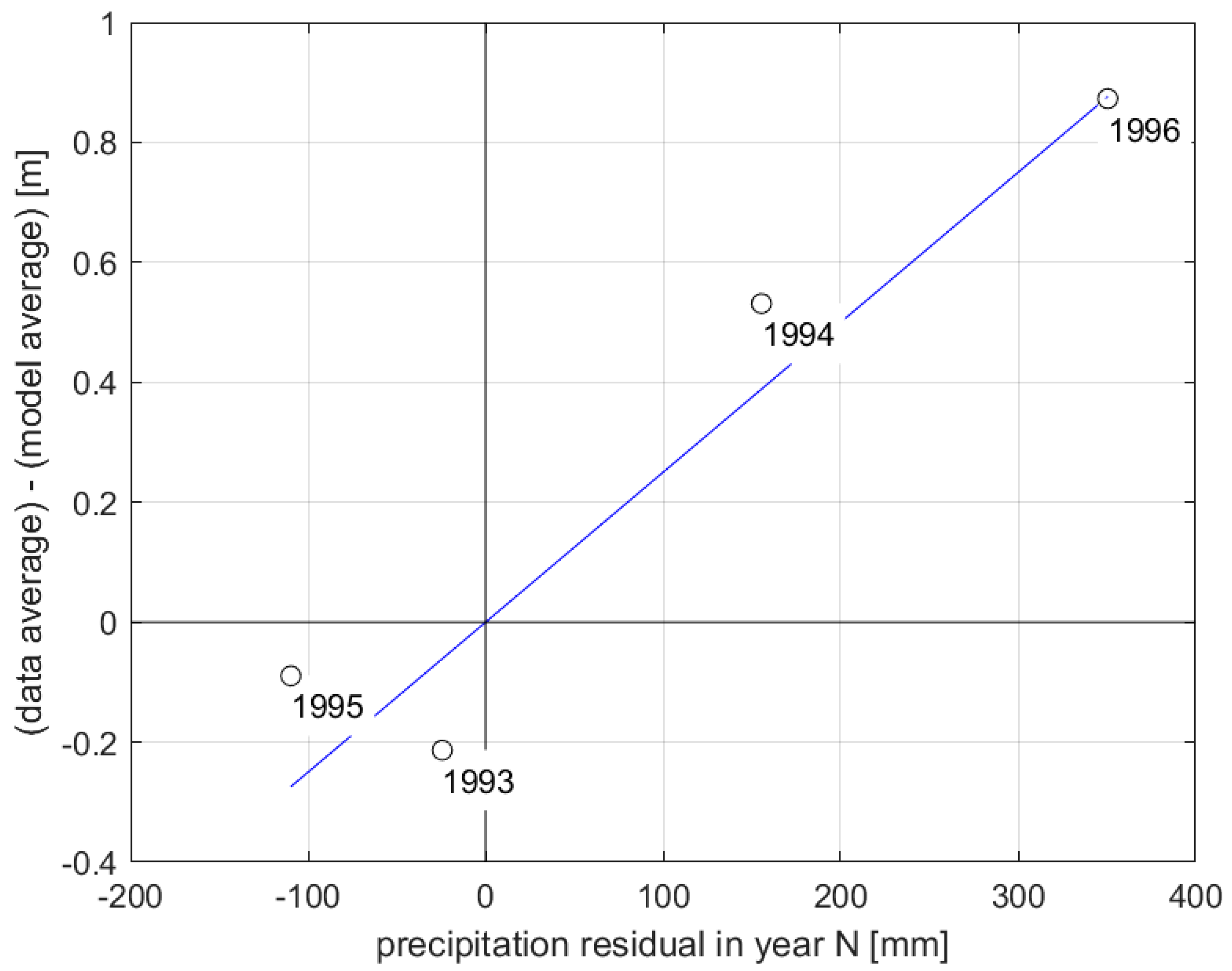
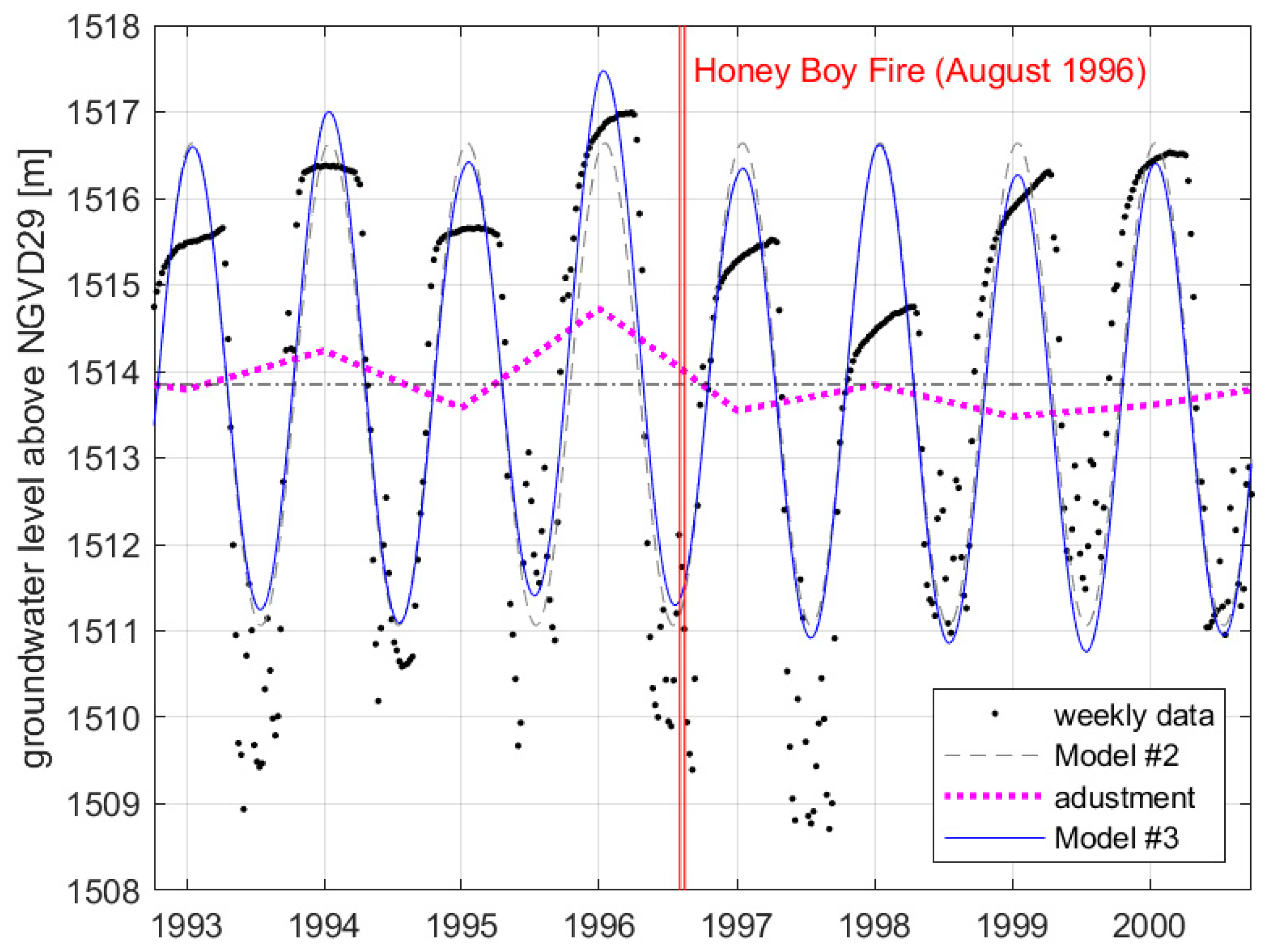

| Wildfire Type | Maximum Area (ac) | Maximum Area (ha) | Assumed Radius (°) |
|---|---|---|---|
| C | 100 | 40 | 0.005 |
| D | 300 | 120 | 0.007 |
| E | 1000 | 400 | 0.011 |
| F | 5000 | 2000 | 0.026 |
| G | none | none | 0.036 |
| Wildfire Class | Number of Groundwater Wells within the Approximated Burn Radius | Number of Groundwater Wells with a Theoretical Score Higher Than 0.5 |
|---|---|---|
| Type C Wildfires | 22 | 5 |
| Type D Wildfires | 5 | 1 |
| Type E Wildfires | 25 | 4 |
| Type F Wildfires | 136 | 30 |
| Type G Wildfires | 143 | 25 |
| Totals | 331 | 65 |
| Chart Date | Annual Precipitation (ft) | Annual Precipitation (mm) | Precipitation Residual (mm) |
|---|---|---|---|
| 2 January 1993 | 1.49 | 454 | −14 |
| 2 January 1994 | 2.08 | 634 | 166 |
| 2 January 1995 | 1.21 | 369 | −100 |
| 2 January 1996 | 2.72 | 829 | 361 |
| 2 January 1997 | 1.17 | 357 | −112 |
| 2 January 1998 | 1.56 | 475 | 7 |
| 2 January 1999 | 1.08 | 329 | −139 |
| 2 January 2000 | 1.25 | 381 | −87 |
| Pre-Fire | All Dates | |||
|---|---|---|---|---|
| Model | RMSE | Improvement | RMSE | Improvement |
| 1—average | 1.67 | - | 2.28 | - |
| 2—sinusoid | 0.76 | 55% | 1.14 | 50% |
| 3—precipitation adjusted | 0.72 | 4.3% | 1.15 | −0.9% |
| 4—fire adjusted | 0.72 | 0.0% | 1.08 | 6.3% |
Publisher’s Note: MDPI stays neutral with regard to jurisdictional claims in published maps and institutional affiliations. |
© 2021 by the authors. Licensee MDPI, Basel, Switzerland. This article is an open access article distributed under the terms and conditions of the Creative Commons Attribution (CC BY) license (https://creativecommons.org/licenses/by/4.0/).
Share and Cite
Johnk, B.T.; Mays, D.C. Wildfire Impacts on Groundwater Aquifers: A Case Study of the 1996 Honey Boy Fire in Beaver County, Utah, USA. Water 2021, 13, 2279. https://doi.org/10.3390/w13162279
Johnk BT, Mays DC. Wildfire Impacts on Groundwater Aquifers: A Case Study of the 1996 Honey Boy Fire in Beaver County, Utah, USA. Water. 2021; 13(16):2279. https://doi.org/10.3390/w13162279
Chicago/Turabian StyleJohnk, Benjamin T., and David C. Mays. 2021. "Wildfire Impacts on Groundwater Aquifers: A Case Study of the 1996 Honey Boy Fire in Beaver County, Utah, USA" Water 13, no. 16: 2279. https://doi.org/10.3390/w13162279
APA StyleJohnk, B. T., & Mays, D. C. (2021). Wildfire Impacts on Groundwater Aquifers: A Case Study of the 1996 Honey Boy Fire in Beaver County, Utah, USA. Water, 13(16), 2279. https://doi.org/10.3390/w13162279







